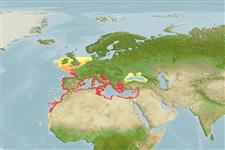Common names from other countries
Environment: milieu / climate zone / depth range / distribution range
Ekologi
laut bentopelagis; kisaran kedalaman 0 - 200 m (Ref. 3688), usually 15 - 50 m (Ref. 54220). Subtropical; 56°N - 12°N, 23°W - 42°E (Ref. 54220)
Eastern Atlantic: British Isles to Cape Blanc, Mauritania; (exceptionally further south) Senegal and around the Canary Islands and Madeira. Common south of 40°N (Spain, North Africa) in the Mediterranean (Ref. 4781).
Length at first maturity / Size / Weight / umur
Maturity: Lm 34.6 range ? - ? cm
Max length : 100.0 cm TL jantan/; (Ref. 3397); common length : 50.0 cm TL jantan/; (Ref. 3688); Berat maksimum terpublikasi: 14.3 kg (Ref. 40637)
deskripsi pendek
Kunci identifiaksi (pengenalan) | Morfologi | Morfometrik
Duri punggung (Keseluruhan (total)) : 11; duri punggung lunak (Keseluruhan (total)) : 11 - 12; Duri dubur: 3; Sirip dubur lunak: 7 - 9. Body oval and compressed. Canine teeth, with 4 to 6 anterior teeth very developed in each jaw.
Inhabit hard bottoms (rock or rubble) down to 200 m depth. Usually found in shallow water less than 50 m deep (Ref. 9987). Adults solitary; young gregarious (Ref. 12482). Young fish caught with traps. Feed on fish, mollusks and cephalopods. Important food fish. Marketed fresh or frozen (Ref. 9987). Some attempts to culture this species have been successful. Due to low market supply, the potential for selling these fish from aquaculture operations seems to be good (Ref. 9987). A spear-fisherman cites a specimen caught in Greece (Corfu) with an overnight bottom-line about 1.60 m and 42 kg (Ref. 48271), but the identification cannot be verified.
Gonochoric, but some specimens are hermaphroditic. Species of separated sexes (although some individuals may be hermaphrodite in young stages). In the Mediterranean, reproduction takes place between March and May, in areas near the coast. Embryo development lasts about 3 days at 17°C.
Bauchot, M.-L. and J.-C. Hureau, 1990. Sparidae. p. 790-812. In J.C. Quero, J.C. Hureau, C. Karrer, A. Post and L. Saldanha (eds.) Check-list of the fishes of the eastern tropical Atlantic (CLOFETA). JNICT, Lisbon; SEI, Paris; and UNESCO, Paris. Vol. 2. (Ref. 3688)
Status IUCN Red List (Ref. 130435)
CITES (Ref. 128078)
Not Evaluated
ancaman kepada manusia
Harmless
penggunaan manusia
Perikanan: komersial; Budidaya air: komersial; Ikan buruan: ya
Alat, peralatan
laporan khas
muat turun XML
Sumber internet
Estimates based on models
Preferred temperature (Ref.
115969): 13.3 - 21.1, mean 18.1 (based on 298 cells).
Phylogenetic diversity index (Ref.
82804): PD
50 = 0.5001 [Uniqueness, from 0.5 = low to 2.0 = high].
Bayesian length-weight: a=0.01122 (0.00948 - 0.01328), b=3.03 (3.00 - 3.06), in cm Total Length, based on LWR estimates for this species (Ref.
93245).
Trophic level (Ref.
69278): 4.5 ±0.4 se; based on diet studies.
Daya lenting (Ref.
120179): Rendah, Waktu penggandaan populasi minimum 4.5 - 14 tahun (K=0.1; tm=2-3).
Prior r = 0.39, 95% CL = 0.26 - 0.58, Based on 9 data-limited stock assessments.
Fishing Vulnerability (Ref.
59153): High to very high vulnerability (66 of 100).
Climate Vulnerability (Ref.
125649): High vulnerability (63 of 100).
